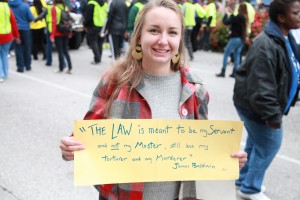
Jon Platt | Lariat Reporter
By Jon Platt
Reporter
ST. LOUIS — Social media brought activists from across the country together in St. Louis for a stance against injustice during Ferguson October, which was labeled a “weekend of resistance” by activists.
During Saturday’s demonstration, the largest such gathering in St. Louis, an estimated 2,000 people peacefully organized for the third Ferguson October event.
Friday, several hundred demonstrators gathered outside the office of Bob McCulloch, the St. Louis county prosecutor. They later marched to the Ferguson police station and neither assembly purported any form of violence.
Throughout the rally Saturday, demonstrations remained civil and neither activists nor police committed violence towards one another.
But, when an estimated 100 activists rallied outside Missouri Gov. Jay Nixon’s office, police issued instructions to leave the property. Nine protestors remained and were subsequently arrested by police for failure to disperse.
Hedy Epstein, a 90-year-old Holocaust survivor, was one of the nine arrested, eyewitnesses confirmed. Epstein has spent most of her life protesting against oppression and has marched alongside Israelis and Palestinians in the West Bank. She lives in St. Louis and speaks to organization around the world about equality, acceptance and her Holocaust experience.
At Saturday’s march, Epstein marched alongside a group of Palestinian sympathizers.
The movement in St. Louis was born out of the killing in Ferguson, Mo. of Michael Brown, an 18-year-old African-American male, by Darren Wilson, a Ferguson police officer, who has since been put on paid administrative leave. The fatal confrontation occurred 64 days before Saturday’s gathering.
Hashtags used by demonstrators, #Ferguson and #FergusonOctober, trended on and off of both Twitter and Facebook on Friday and Saturday.
While the community of Ferguson was active in the march, hundreds more from across the country also arrived to show support.
“This is our opportunity to make a difference,” said Marina Escamilla, a college student from San Antonio. “This is just the beginning of what our reach is going to be. I’m from San Antonio, but I came up because I want to participate and I want to see them be heard.”
Escamilla said she followed the movement’s growth over the past few weeks with Twitter. Social media provided her a way to engage and connect with people on the ground in St. Louis and Ferguson from over 800 miles away, she said.
Without Twitter, Escamilla said she thought the massive reach of the movement would not have been possible.
As the large crowd navigated through the streets, many sang old spirituals. “This Little Light of Mine” and “We Shall Overcome” were frequent choices. Marchers also chanted sayings, such as “Not one more!” “Hands up! Don’t shoot!” and “Fight back!”
Also at the rally was 76-year-old veteran marcher Pat Piety, who lives in the south part of St. Louis. She said she has been to many demonstrations over the years.
“I’ve just worked for civil rights my whole life,” Piety said. “My husband was a civil rights reporter in East St. Louis in the 60s and we were in a lot of rallies there. And, I’ve seen a lot of progress since that time, but also a lot of regression.”
Piety, a white woman, said marched Saturday to show her support of people moving for justice. As one representative of the majority among oppressed minorities, she said she wants to prove that stereotypes don’t work either way — towards the minority or majority.
“I think a lot of white people still don’t understand that this could happen to them,” she said.
Piety said many of her friends are of other races. And that one, an African-American FBI worker, gave her the sweatshirt she wore at the march, which read “FBI Academy.”
She said she gets a lot of weird looks for the shirt, but wears it as a personal reminder that not everyone is the stereotype that society places on them. Her friend at the FBI is not a bad cop, she said, in the same way that not every young African-American male is a criminal.
As the crowd gathered in Kiener Park, after marching passed the downtown courthouse, singing, chanting and dancing began. Epstein was helped through the back of the crowd on the arm of a friend and she wore a smile as she gazed at the crowd.
Escamlla said she was amazed so many different groups of people were represented at the gathering. Present were members of various churches, nurses, artists and many nonprofit workers focused on community awareness and racial justice.
Black, white, and all colors in between were present Saturday, Escamilla said.
“This is the most unity I’ve ever seen,” she said. “It’s a lot to take in.”
The St. Louis Police Department, the Missouri State police force and the St. Louis County Sheriff’s Department each declined to comment on the gathering and recent incidents, but all actively patrolled Saturday’s march.
On Sunday, members of the gathering will meet at Epiphany United Church of Christ for Hands-Up Sabbath, a time of worship and reflection specifically focused on Brown’s death and a long-term plan for appropriate Christian response, according to FergusonOctober.com.






